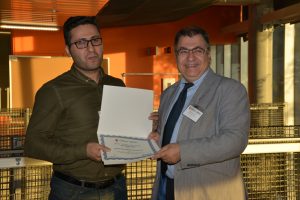EDITORIAL
On October 12th the participants in the 6th edition of the ReSMiQ Innovation Day gathered at Polytechnique Montréal to attend the keynote speeches and several technical demonstrations. This annual event organized by our center aims to give visibility to the research work done by graduate and undergraduate students of the province of Quebec in the field of microsystems. We wish to thank Mounir Boukadoum from UQAM and Benoit Gosselin from Université Laval, both members of ReSMiQ, as well as Jose M. de la Rosa from the university of Sevilla in Spain and Hao Yu from the Southern University of Science and Technology in Shenzhen in China for their involvement.

Students at all levels (CEGEP, university undergraduate and graduate) showed their scientific and technical expertise during a competition through experimental demonstrations to a jury constituted of many experts. The best projects in each category were awarded prizes as well as special awards from IEEE Montréal and the Montréal Chapter of the IEEE SSCS society. This year, 12 projects were presented (more details). We thank all the students who submitted their project as well as congratulate the winners. We hope to see more new innovations for the next edition in October 2018.
Undergraduate level winner

Bague IMU pour contrôle d’un bras robotique pour assistance quotidienne
by Tristan Robitaille (DEC), Collège Sainte-Anne
Graduate level winners

1e prix – Un SoC CMOS Mixte en Technologie 0.13 μm pour l’Optogénétique et l’Enregistrement Neuronal en Boucle Fermée
by Gabriel Gagnon-Turcotte (Ph.D.), Université Laval

2e prix – Wireless Optoelectronic Interface Enabling Brain Fiber Photometry in Freely Behaving Rodents
by Mehdi Noormohammadi Khiarak (Ph.D.), Université Laval

3e prix – Rotational MEMS Platform for Optical Switching
by Suraj Sharma (Ph.D.), École de technologie supérieure
Prix spéciaux
Prix IEEE Montréal
Multimodal implantable neural interfacing microsystem
by Massoud Rezaei (Ph.D.), Université Laval
Prix IEEE Montréal SSCS Chapter
Wireless power and data transmissions in harsh environment applications
by Ahmad Hassan (Ph.D.), Polytechnique Montréal
ReSMiQ is a group of researchers in an interuniversity research center that can count on the support of the Fonds de recherche du Québec – Nature et technologies (FRQNT) and nine (9) Quebec universities involved in microsystems research.
NEWS FROM OUR MEMBERS
Achievements
– Dr. Massicotte from UQTR received a grant from MITACS as part of their Accelerate program in partnership with the company Simaudio.
Exposure
– Dr. Frédéric Nabki from ETS and Dr. Michael Ménard from UQAM are collaborating on the development of a chip in partnership with company Aeponyx and was praised as one of the “Ten great inventions made in Québec” by the magazine Québec Science.
More details
Involvment
– Dr. Warren Gross from McGill University is the general co-chair of IEEE GlobalSIP 2017 to be held in Montréal from November 14 to 16, 2018.
More details
RESMIQ’S ACTIVITIES
Intensive course
Title : Conception IPC intégrée des PCB HDI pour les cartes électroniques en haute fréquence
Date: November 22 and 23, 2017
Place: Université de Sherbrooke, Centre d’excellence en système intelligents intégrés
Plus de détails
Scholarships and financial support
Scholarship and financial support for graduate students
APPLICATION DEADLINE: January 15, 2018
More details
Bourse scholarship for postdoctoral fellows
APPLICATION DEADLINE: January 15, 2018
More details
SIGNAL is the main monthly information medium of the Microsystems Strategic Alliance of Québec (ReSMiQ). This newsletter aims to be an active link between the members of ReSMiQ and all individuals who have an interest in research and innovation in microsystems. We commit ourselves to promote in it our members’ research and increase ReSMiQ’s visibility.
ReSMiQ is a group of researchers in an interuniversity research center that can count on the support of the Fonds de recherche du Québec – Nature et technologies (FRQNT) and nine (9) Quebec universities involved in microsystems research.






